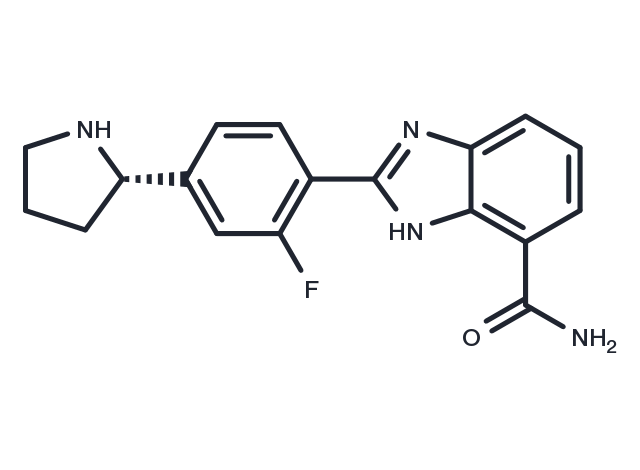Powder: -20°C for 3 years | In solvent: -80°C for 1 year


A-96649 is a new-type and effective inhibitor. The Ki of A-966492 for PARP1 and PARP2 is 1 nM and 1.5 nM, respectively.

| Pack Size | Availability | Price/USD | Quantity |
|---|---|---|---|
| 1 mg | In stock | $ 47.00 | |
| 5 mg | In stock | $ 97.00 | |
| 10 mg | In stock | $ 187.00 | |
| 25 mg | In stock | $ 348.00 | |
| 50 mg | In stock | $ 587.00 | |
| 100 mg | In stock | $ 837.00 | |
| 1 mL * 10 mM (in DMSO) | In stock | $ 112.00 |



| Description | A-96649 is a new-type and effective inhibitor. The Ki of A-966492 for PARP1 and PARP2 is 1 nM and 1.5 nM, respectively. |
| Targets&IC50 | PARP2:1.5 nM(Ki), PARP1:1 nM(ki) |
| In vitro | A-966492 stands out as a highly potent inhibitor of PARP, demonstrating exceptional efficacy against the PARP-1 enzyme with a Kiof 1 nM and an EC50 of 1 nM in whole-cell assays. It markedly boosts the effectiveness of TMZ in a dose-dependent fashion. Additionally, A-966492 exhibits oral bioavailability in various species, can traverse the blood−brain barrier, and seems to infiltrate tumor tissues effectively. Representing a promising benzimidazole analogue with structural diversity, A-966492 is currently undergoing further preclinical characterization. [1] |
| In vivo | A-966492 exhibits robust in vivo efficacy, particularly when used in combination with temozolomide (TMZ) in a B16F10 subcutaneous murine melanoma model and carboplatin in an MX-1 breast cancer xenograft model, alongside demonstrating effectiveness as a single agent in a BRCA1-deficient MX-1 tumor model. This compound also showcases excellent pharmaceutical properties, achieving oral bioavailabilities between 34−72% and half-lives of 1.7−1.9 hours in Sprague−Dawley rats, beagle dogs, and cynomolgus monkeys. Furthermore, A-966492 significantly enhances the efficacy of TMZ in a murine B16F10 syngeneic melanoma model, with combination therapy groups showing superior efficacy. |
| Kinase Assay | PARP Enzyme Assay: The enzyme assay is conducted in buffer containing 50 mM Tris, pH 8.0, 1 mM dithiothreitol(DTT), and 4 mM MgCl2. PARP reactions contains 1.5 μM [3H]-NAD+ (1.6 μCi/mmol), 200 nM biotinylated histone H1, 200 nM slDNA, and 1 nM PARP-1 or 4 nM PARP-2 enzyme. Autoreactions utilizing SPA bead-based detection are carried out in 100 μL volumes in white 96-well plates. Reactions are initiated by adding 50 μL of 2X NAD+ substrate mixture to 50 μL of 2× enzyme mixture containing PARP and DNA. These reactions are terminated by the addition of 150 μL of 1.5 mM benzamide (~1 × 103-fold over its IC50). A 170 μL amount of the stopped reaction mixtures is transferred to streptavidin-coated Flash Plates, incubated for 1 hour, and counted using a TopCount microplate scintillation counter. Ki data are determined from inhibition curves at various substrate concentrations. |
| Cell Research | C41 cells are treated with A-966492 for 30 minutes in a 96-well plate. PARP are activated by damaging DNA with 1 mM Water2 for 10 minutes. Cells are washed with ice-cold phosphate-buffered saline (PBS) once and fixed with prechilled methanol/acetone (7:3) at -20 °C for 10 minutes. After they are air-dried, plates are rehydrated with PBS and blocked using 5% nonfat dry milk in PBS-Tween(0.05%) (blocking solution) for 30 minutes at room temperature. Cells are incubated with anti-PAR antibody 10H (1:50) in blocking solution at room temperature for 60 minutes followed by washing with PBS-Tween20 five times, and incubation with goat antimouse fluorescein 5(6)-isothiocyanate (FITC)-coupled antibody (1:50) and 1 μg/mL 40,6-diamidino-2-phenylindole (DAPI) in blocking solution at room temperature for 60 minutes. After washing with PBS-Tween20 5 times, analysis is performed using an fmax Fluorescence Microplate Reader set at the excitation and emission wavelength for FITC or the excitation and emission wavelength for DAPI. PARP activity (FITC signal) is normalized with cell numbers (DAPI).(Only for Reference) |
| Molecular Weight | 324.35 |
| Formula | C18H17FN4O |
| CAS No. | 934162-61-5 |
Powder: -20°C for 3 years | In solvent: -80°C for 1 year
H2O: < 1 mg/mL (insoluble or slightly soluble)
Ethanol: < 1 mg/mL (insoluble or slightly soluble)
DMSO: 60 mg/mL (185 mM)
You can also refer to dose conversion for different animals. More
bottom
Please see Inhibitor Handling Instructions for more frequently ask questions. Topics include: how to prepare stock solutions, how to store products, and cautions on cell-based assays & animal experiments, etc.
A-966492 934162-61-5 Chromatin/Epigenetic DNA Damage/DNA Repair PARP poly ADP ribose polymerase A966492 A 966492 Inhibitor inhibit inhibitor
